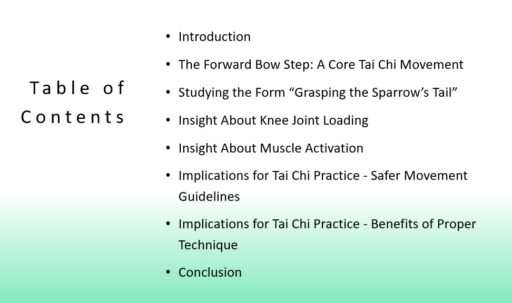Tai Chi’s forward bow step, a key movement for enhancing stability and flexibility, places varying biomechanical demands on the knee joint depending on posture. A recent study reported by Frontiers in Bioengineering and Biotechnology explored how different knee positions affect joint load and muscle coordination, offering valuable insights for safer practice.
Researchers analyzed three forward bow step positions:
- NETT (Knee Not Exceeding the Tip of the Foot): Minimal forward knee movement.
- LTT (Knee Level with the Tip of the Foot): Moderate forward knee movement.
- ETT (Knee Exceeding the Tip of the Foot): Maximum forward knee movement.
Using motion capture, force platforms, and electromyography, the team evaluated knee joint angles, ligament forces, and muscle activation.

A tutorial with details is available for ATCQA Members and Certified Instructors/Practitioners. Other people can purchase the tutorial for a small fee in our online store.
The study found that the NETT position significantly reduced knee joint load compared to LTT and ETT.
Practicing the forward bow step with NETT positioning minimizes joint stress and supports long-term knee health. While LTT offers a balance between engagement and safety, ETT’s higher demand on ligaments and muscles makes it less advisable, especially for individuals with existing knee concerns.
By understanding these findings, Tai Chi practitioners can optimize their movements for both safety and effectiveness, ensuring a sustainable and therapeutic practice.